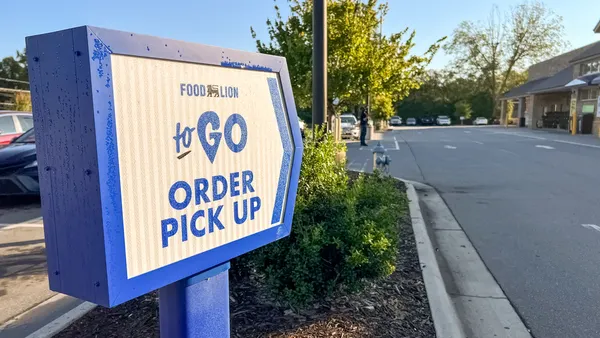Dive Brief:
- A new Gallup poll shows that few Americans are buying groceries online or subscribing to meal prep kits, despite the prevalence and growth of these services. Among the key findings, 84% of those polled say they never order groceries online, while 81% of Americans surveyed say they shop for groceries in person once a week or more.
- About 14% of parents with children under age 18 say they order groceries online on a monthly basis versus 7% of those without children. It is also more common for Americans earning more than $75,000 annually to purchase groceries online — at 12%, versus 7% of those who make less.
- The report says that while Americans show a willingness to shop online and are not deterred by technology, there are a number of factors that hold them back from purchasing groceries online including budgets, personal preferences and meal planning.
Dive Insight:
The buzz around new technologies, services and disruption in the grocery industry make the findings of this poll eye-opening. However, the results from Gallup's poll are similar to those of other organizations. With online purchases making up only 5.5% of total grocery spending in the U.S. — most of which come from a core group of households — not that many consumers are consistently buying groceries online.
Based on the poll, while millennials, people who live in urban cores and those with high incomes are making online purchases, the numbers are still low. Gallup’s report concludes that Americans are traditionalists when it comes to buying food and they don’t plan that far in advance on what to eat — making last-minute trips to the grocery store the most useful mechanism for shopping.
There are a few issues that may hinder shoppers from purchasing online, including delivery, experience and purchasing control. Several stores are in the early stages of introducing grocery delivery, and shoppers who buy online often do so for convenience. They may not want to drive to the grocery store to pick up their orders. Additionally, the overall online purchasing experience may still be rocky as grocers work through the kinks of website and app functionality, fees for online orders or delivery, and order fulfillment logistics. Another possibility is some shoppers purchase online one or two times but don’t stick with it when they realize they have less control over the quality of their fresh foods.
To address these concerns, grocers can modify the online experience to make it easy for buyers to customize their choices. They might also want to incorporate offers, products or discounts that are unique and incentivize online purchases.
Still, other findings indicate that online grocery shopping is on the upswing and continues to be in a growth stage, so perhaps it is just a matter of time before it reaches a tipping point.
Ultimately, does the route to purchase affect a grocer’s bottom line? Most grocers are upping their digital game to stay competitive with Amazon, but among repeat customers, a sale is a sale whether it is made online or in person. If store experiences draw more customers in, they may generate even more revenue than grocery purchases made online.













